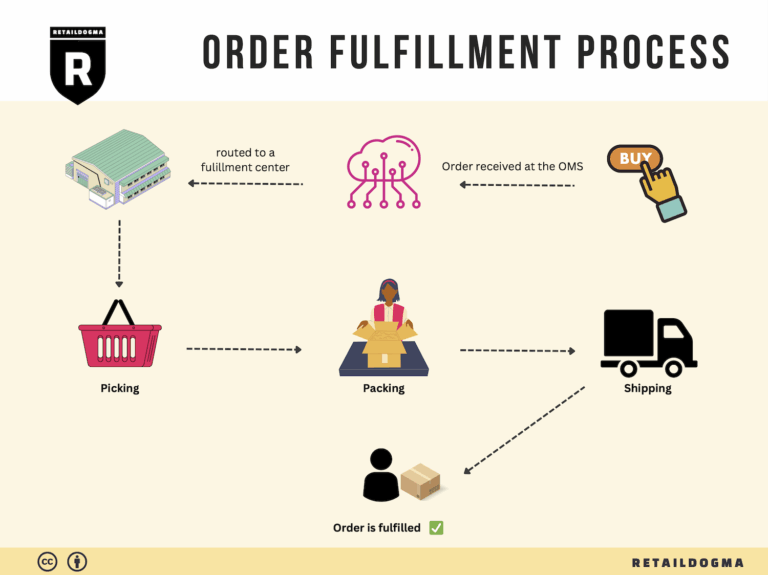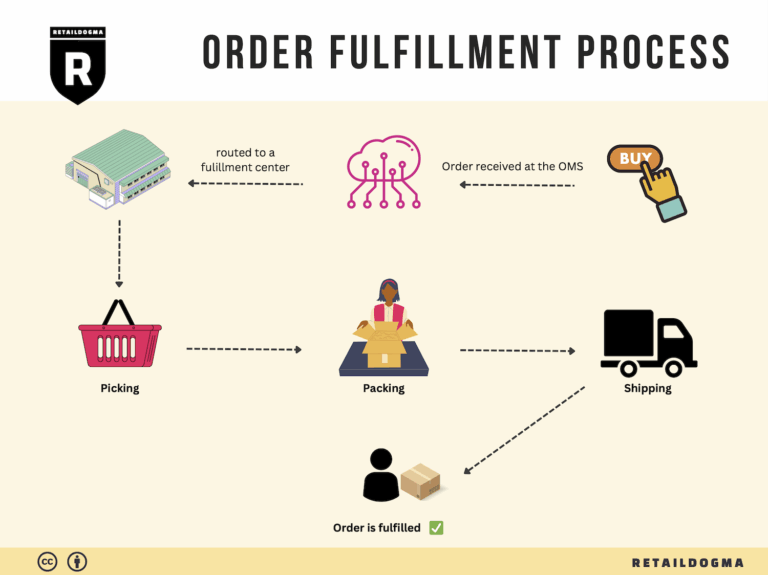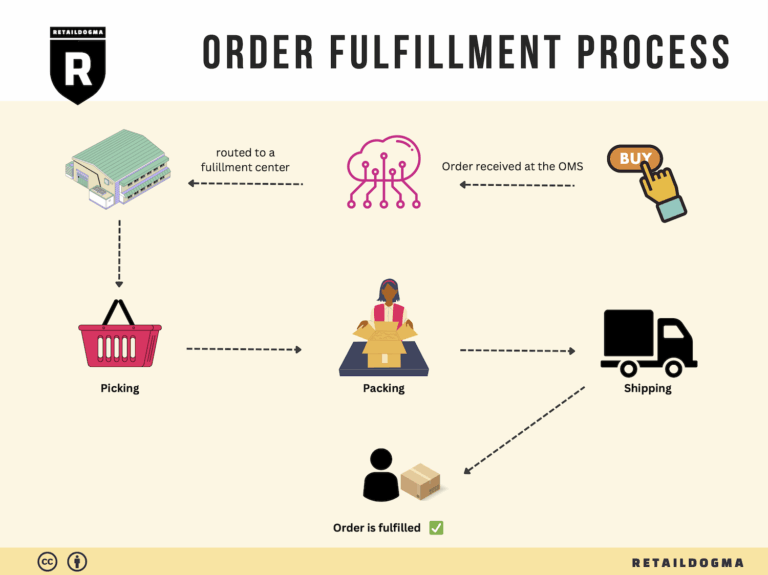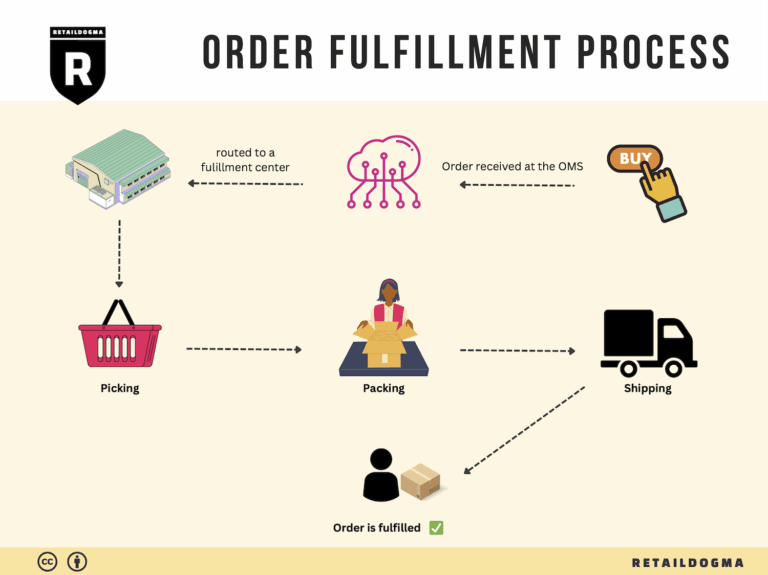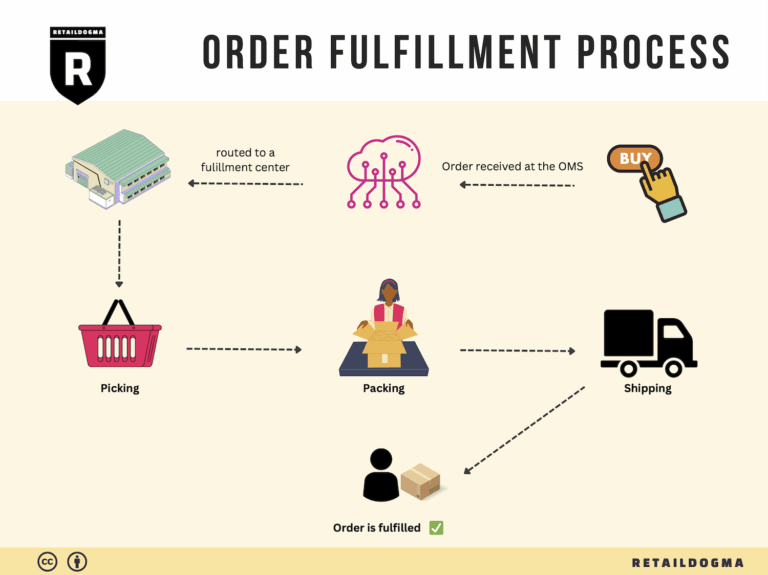Ecommerce Fulfillment Services: The Ultimate Guide (2025)
What is E-commerce Fulfillment? An Introduction for Growing Businesses
Understanding E-commerce Fulfillment
As a growing online business, one of the most common challenges you face is managing the overwhelming logistics of packing and shipping orders. The excitement of making sales can quickly turn into stress when you find yourself buried in boxes, packing materials, and shipping labels. This is where e-commerce fulfillment comes into play. At its core, fulfillment is the process of getting your products into the hands of your customers efficiently and effectively.
E-commerce fulfillment encompasses several critical tasks that ensure your customers receive their orders promptly. This includes warehousing, inventory management, order processing, packing, and shipping. As your business scales, the complexity of these tasks can grow exponentially. Therefore, understanding your fulfillment options is crucial for maintaining customer satisfaction and operational efficiency.
In this guide, we will explore various fulfillment models that can support your growing business. From traditional third-party logistics (3PL) providers to Amazon’s Fulfillment by Amazon (FBA) service, each model offers unique advantages and considerations. We’ll break down the core services each model provides, helping you understand what to expect from potential partners.
Choosing the right fulfillment partner is a critical decision that can impact your business’s bottom line and customer experience. We will outline key factors to consider, such as service offerings, technology integration, and geographic coverage. Additionally, understanding pricing structures will help you evaluate the cost-effectiveness of different fulfillment solutions and avoid hidden fees that could erode your margins.
Our goal with this guide is to empower you as a business owner or operations manager to make informed decisions about your logistics strategy. By understanding the fundamentals of e-commerce fulfillment and the options available to you, you can streamline your operations, enhance customer satisfaction, and ultimately scale your business with confidence. Whether you are just starting or looking to refine your existing processes, the insights provided here will help you navigate the complexities of fulfillment and set your business up for success.
What You’ll Learn In This Guide
- What is E-commerce Fulfillment? An Introduction for Growing Businesses
- The Order Fulfillment Process: From ‘Buy’ Button to Customer’s Door
- Comparing Fulfillment Models: In-House vs. 3PL vs. Dropshipping
- A Deep Dive into Amazon FBA: Pros, Cons, and Who It’s For
- Core Services Offered by Fulfillment Centers
- How to Choose a Fulfillment Partner: A 6-Point Checklist
- Understanding Fulfillment Pricing: A Breakdown of Common Fees
- Frequently Asked Questions (FAQs) about Fulfillment
- Conclusion: Is Outsourcing Fulfillment the Right Move for Your Business?
- Important Disclaimer
The Order Fulfillment Process: From ‘Buy’ Button to Customer’s Door
1. Receiving Inventory
The order fulfillment process begins with receiving inventory at the fulfillment center. This step is crucial as it sets the foundation for all subsequent operations. When products arrive, they are checked against purchase orders to ensure the correct quantities and items have been delivered. Each item is assigned a Stock Keeping Unit (SKU), which is a unique identifier that helps in tracking and managing inventory levels.
Proper receiving protocols not only minimize errors but also help maintain an accurate inventory count. This is essential for effective inventory management, as discrepancies can lead to stockouts or overstock situations, impacting sales and customer satisfaction. Efficient receiving also includes quality checks to identify any damaged items, which can be returned to the supplier for replacement.
2. Warehouse Storage
Once the inventory is received and verified, it is organized and stored in the fulfillment center. This step involves placing items in designated storage locations, which can include shelves, bins, or pallets. The organization system often employs a combination of methods, such as FIFO (First In, First Out) or LIFO (Last In, First Out), to optimize space and facilitate quicker retrieval of products.
Effective warehouse storage is vital for operational efficiency. A well-organized storage system reduces the time it takes to locate items, which is especially important during peak sales periods when order volumes increase. Additionally, utilizing technology such as Warehouse Management Systems (WMS) can enhance visibility into inventory levels and locations, allowing for better forecasting and planning.
3. Order Picking
The next step is order picking, where items are retrieved from their storage locations based on customer orders. Fulfillment centers typically generate pick lists, which are documents or digital notifications that indicate the specific items and quantities needed for each order. This process can be performed using various methods, including single-order picking, batch picking, or zone picking.
Efficient order picking is critical for maintaining fast processing times and ensuring customer satisfaction. The speed and accuracy of this step directly influence delivery times. To enhance picking efficiency, many businesses employ technologies such as barcode scanning and mobile devices, which help reduce errors and streamline the picking process. Additionally, optimizing pick paths— the route taken to collect items—can significantly decrease the time spent picking orders.
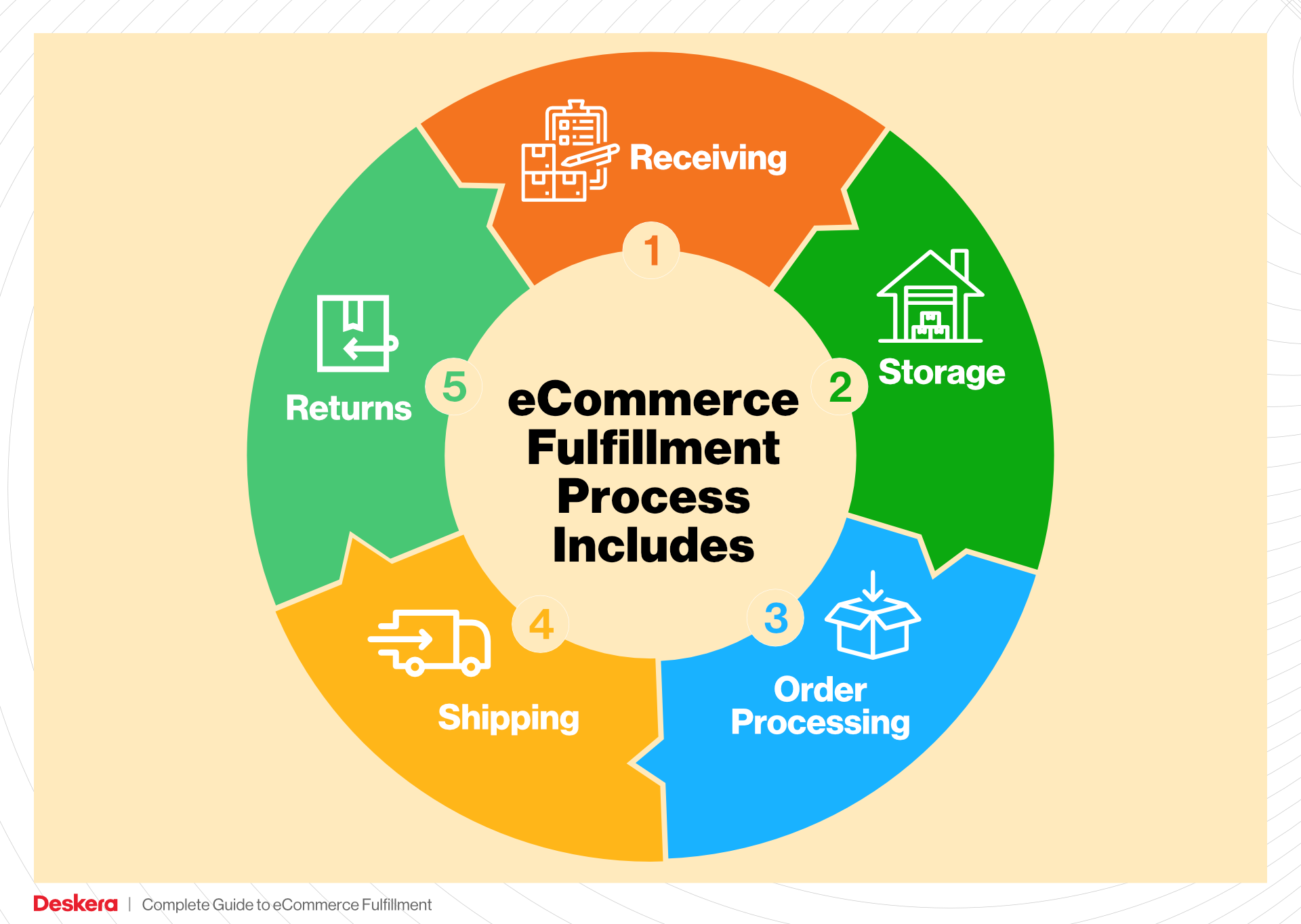
4. Order Packing
After items are picked, they move to the packing stage. During this step, products are carefully packed into boxes or envelopes, ensuring they are secure and protected for transit. This process also involves labeling each package with shipping information, including tracking numbers and addresses. Proper packing materials, such as bubble wrap or packing peanuts, are utilized to prevent damage during shipping.
The packing phase is important for several reasons. First, it ensures that products arrive at their destination in good condition, which is critical for maintaining customer satisfaction and trust. Additionally, efficient packing can help reduce shipping costs by optimizing box sizes and minimizing excess weight. Businesses that implement packing stations equipped with technology can further enhance efficiency by automating label printing and tracking.
5. Shipping & Delivery
The final step in the order fulfillment process is shipping and delivery. Once packages are packed, they are handed off to carriers for transportation to the customer’s address. This step involves selecting the appropriate shipping method based on factors such as cost, speed, and destination. Many fulfillment centers use a mix of carriers, including USPS, FedEx, and UPS, to provide customers with multiple shipping options.
Timely shipping and delivery are essential for customer satisfaction. Customers expect their orders to arrive quickly and in perfect condition. By providing accurate tracking information, businesses can keep customers informed about their order status, which enhances the overall customer experience. Moreover, utilizing fulfillment centers strategically located near key markets can significantly reduce shipping times and costs, ultimately leading to improved operational efficiency and customer loyalty.
In conclusion, the order fulfillment process is a multifaceted operation that involves receiving inventory, storing it efficiently, picking orders accurately, packing them securely, and shipping them promptly. Each step is interconnected and plays a vital role in ensuring that customers receive their products as expected. By optimizing these processes, e-commerce businesses can scale operations effectively and improve overall customer satisfaction.
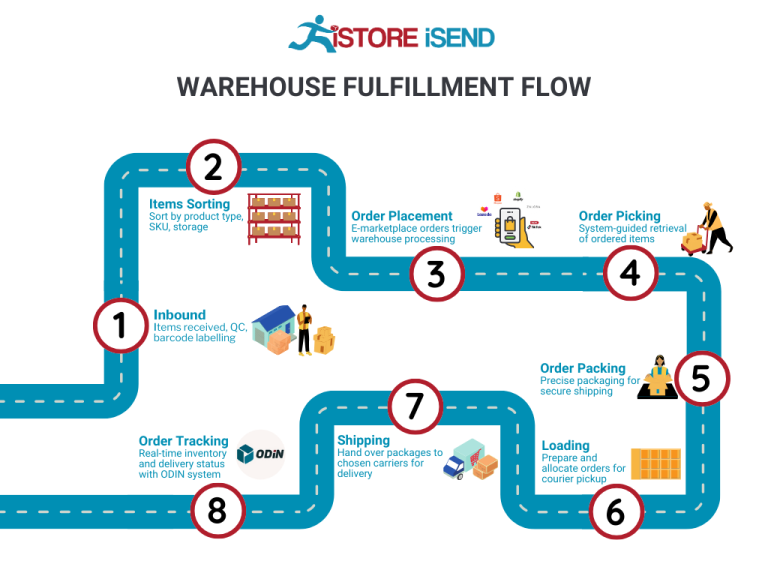
Comparing Fulfillment Models: In-House vs. 3PL vs. Dropshipping
Comparison of Fulfillment Models
| Model | Who Handles Inventory | Best For (Business Stage) | Key Advantage | Key Disadvantage |
|---|---|---|---|---|
| In-House Fulfillment | Business owner/operations team | Established businesses | Full control over inventory | High overhead costs |
| Third-Party Logistics (3PL) | Third-party logistics provider | Growing businesses | Scalability and flexibility | Less control over logistics |
| Dropshipping | Supplier/wholesaler | Startups or niche businesses | Low upfront investment | Lower profit margins and longer shipping times |
In-House Fulfillment
In-house fulfillment refers to a model where the business manages its own inventory and shipping processes. This means that the company takes full responsibility for storing, packing, and shipping products directly to customers. This model is best suited for established businesses that have the resources and scale to handle their logistics operations effectively. The primary advantage of in-house fulfillment is the complete control it offers over inventory management, order processing, and customer service. Businesses can customize packaging, ensure quality control, and maintain direct communication with their customers. However, this model also comes with significant challenges. The overhead costs associated with warehousing, staffing, and technology can be substantial, particularly for small to mid-sized businesses. Additionally, as order volumes fluctuate, companies may struggle with capacity management, leading to inefficiencies and potential fulfillment delays.
Third-Party Logistics (3PL)
Third-party logistics (3PL) involves outsourcing logistics operations to a specialized service provider. In this model, businesses partner with a 3PL provider that manages warehousing, inventory management, and shipping on behalf of the business. This option is ideal for growing businesses that seek to scale operations without the burden of directly managing logistics. The key advantage of using a 3PL provider is the scalability and flexibility it offers. Businesses can quickly adapt to changes in order volume without the need for significant investments in infrastructure or staff. Additionally, 3PL providers often have established networks and expertise that can lead to reduced shipping costs and improved delivery times. However, one of the main disadvantages is the potential loss of control over logistics processes. Companies may find it challenging to ensure the same level of customer service and quality control as when they handled fulfillment in-house. Furthermore, businesses are dependent on the 3PL provider’s reliability, which can impact customer satisfaction if issues arise.
Dropshipping
Dropshipping is a fulfillment model where the retailer does not keep products in stock. Instead, when a retailer sells a product, it purchases the item from a third party—usually a wholesaler or manufacturer—who then ships it directly to the customer. This model is particularly appealing for startups or businesses operating in niche markets, as it requires little upfront investment. Retailers can offer a wide variety of products without the financial burden of inventory storage. The primary advantage of dropshipping is the low barrier to entry, allowing entrepreneurs to test new products and markets without significant risk. However, dropshipping comes with its own set of challenges. Profit margins are typically lower due to the cost of purchasing items from suppliers, and shipping times can be longer, which may lead to customer dissatisfaction. Additionally, retailers have limited control over the fulfillment process, which can result in inconsistent quality and potential inventory shortages if suppliers run out of stock.
A Deep Dive into Amazon FBA: Pros, Cons, and Who It’s For
Understanding Fulfillment by Amazon (FBA)
Fulfillment by Amazon (FBA) is a service provided by Amazon that allows sellers to store their products in Amazon’s fulfillment centers. Amazon takes care of storage, packaging, and shipping, allowing sellers to focus on other aspects of their business. When a customer places an order for a product, Amazon handles the logistics, ensuring fast and reliable delivery. This service is particularly beneficial for e-commerce businesses looking to scale their operations efficiently.
How FBA Works
-
Setting Up Your FBA Account: To start using FBA, sellers must create an Amazon seller account and enable FBA in their settings.
-
Product Listing: Sellers list their products on Amazon, indicating which items will be fulfilled through FBA. This involves providing product details, pricing, and inventory levels.
-
Shipping Inventory to Amazon: Sellers prepare their products for shipment to Amazon’s fulfillment centers. This includes labeling and packaging according to Amazon’s guidelines.
-
Storage: Once the inventory arrives at the fulfillment center, Amazon stores it until it is sold. Sellers can monitor their inventory levels through their seller account.
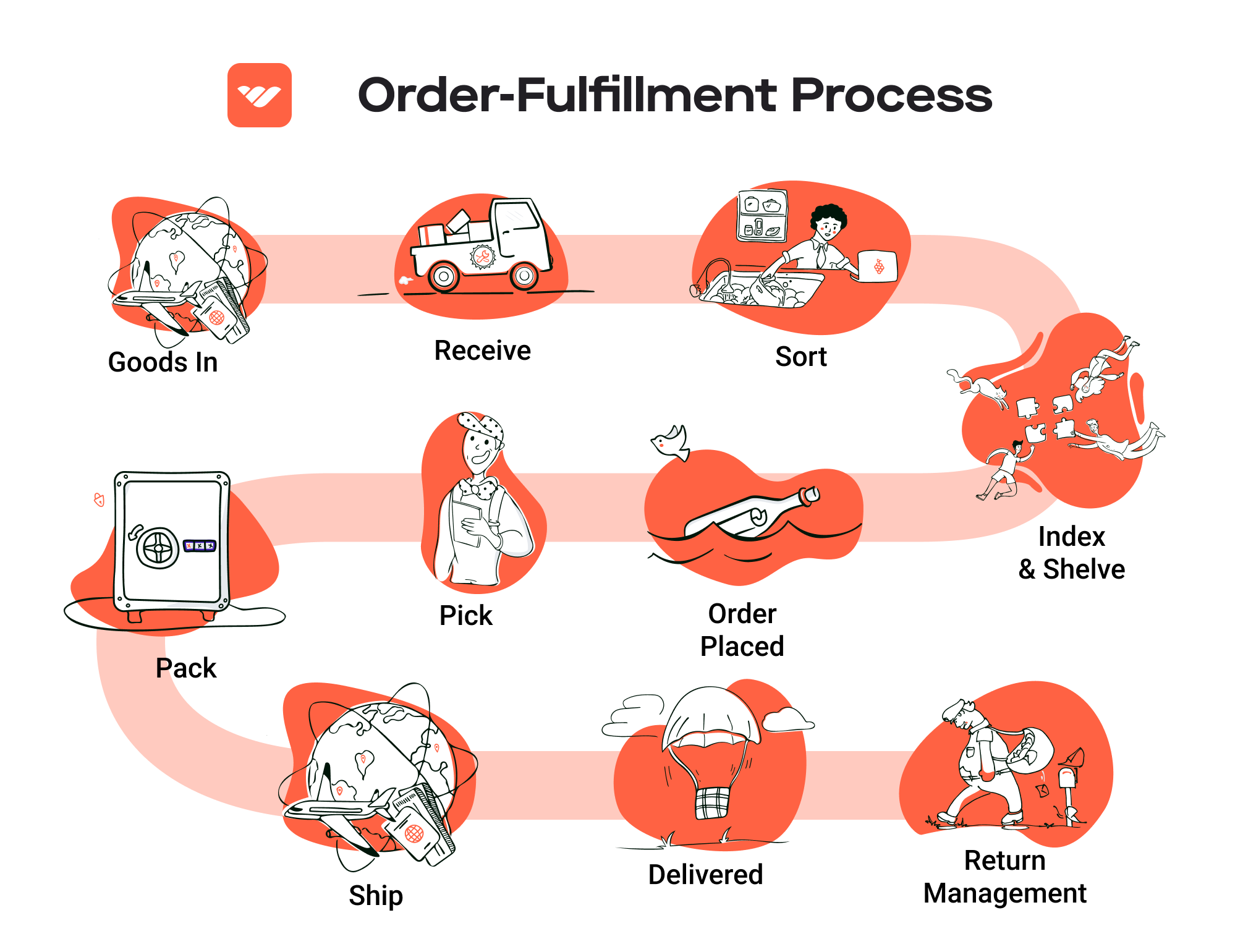
-
Order Fulfillment: When a customer orders a product, Amazon picks, packs, and ships the item on behalf of the seller. Amazon also handles customer service and returns.
-
Payment: After the sale, the seller receives payment from Amazon, minus applicable fees.
Pros of Using FBA
Prime Eligibility
One of the most significant advantages of FBA is that it makes products eligible for Amazon Prime. This increases visibility and attracts a loyal customer base that values fast, reliable shipping. As Prime members often prefer to purchase products eligible for Prime, this can lead to higher sales for sellers.
Customer Trust
Products fulfilled by Amazon benefit from the trust associated with the Amazon brand. Customers are often more willing to purchase items that are backed by Amazon’s fulfillment network due to the assurance of quality service, easy returns, and customer support.
Multi-Channel Fulfillment
FBA is not limited to sales on Amazon. Sellers can utilize FBA to fulfill orders from other sales channels, such as their own websites or other e-commerce platforms. This flexibility allows businesses to streamline their operations and manage inventory more effectively across multiple platforms.
Scalability
FBA provides a scalable solution for businesses of all sizes. As sales grow, sellers can easily increase their inventory levels without needing to invest in additional warehousing or logistics resources.
Automated Logistics
With FBA, sellers benefit from Amazon’s advanced logistics network, which includes sophisticated inventory management, order processing, and shipping capabilities. This automation frees up time for sellers to focus on marketing and product development.
Cons of Using FBA
High Fees
While FBA provides numerous benefits, it comes with costs. Sellers are charged for storage space, fulfillment fees per unit sold, and additional fees for long-term storage. These costs can add up, especially for low-margin products, impacting overall profitability.
Strict Inventory Rules
Sellers must adhere to strict guidelines regarding inventory management and product compliance. This includes adhering to Amazon’s policies on product condition, labeling, and packaging. Failure to comply can lead to penalties or account suspension.
Commingling Risks
FBA products may be commingled, meaning that inventory from different sellers can be stored together. This can lead to issues if a seller’s product is damaged or returns are mishandled. Sellers may receive returns that do not belong to them, complicating inventory management and customer service.
Limited Control
When using FBA, sellers relinquish some control over the fulfillment process. This can be challenging for businesses that prioritize branding and customer experience, as they may not have a direct hand in how their products are packaged or shipped.
Inventory Management Challenges
Managing inventory effectively can be a challenge with FBA. Sellers need to maintain optimal stock levels to avoid stockouts or excessive storage fees. Additionally, fluctuations in demand can lead to overstocking or understocking, complicating financial planning.
Who is FBA Best For?
FBA is best suited for e-commerce businesses looking to scale quickly and efficiently without the burden of managing logistics. It is particularly advantageous for:
-
Small to Medium-Sized Businesses: Those lacking the infrastructure to manage shipping and fulfillment independently can benefit significantly from FBA’s comprehensive services.
-
High-Volume Sellers: Businesses that have a steady stream of sales can leverage FBA to streamline their operations and enhance customer satisfaction.
-
Sellers with Diverse Product Lines: Companies offering a wide range of products can utilize FBA to simplify inventory management across various categories.
-
Brands Looking to Expand: For businesses aiming to reach Amazon’s vast customer base, FBA provides a straightforward path to gaining visibility and credibility.
-
Entrepreneurs Focused on Growth: Those looking to grow their e-commerce business without getting bogged down in logistics will find FBA to be a valuable resource.
In conclusion, while Fulfillment by Amazon offers significant advantages in terms of logistics, customer trust, and scalability, sellers must weigh these benefits against the associated costs and potential drawbacks. By understanding how FBA works and determining whether it aligns with their business goals, sellers can make informed decisions that support their growth strategies in the competitive e-commerce landscape.
Core Services Offered by Fulfillment Centers
Inventory Management & Warehousing
Effective inventory management is crucial for e-commerce businesses, and fulfillment centers excel in providing robust warehousing solutions. These facilities are designed to store a variety of products in an organized manner, allowing for real-time inventory tracking and management. Advanced technology systems, such as barcode scanning and inventory management software, ensure that businesses can monitor stock levels accurately.
Benefits:
-
Space Optimization: Fulfillment centers maximize storage efficiency, allowing businesses to store products without the overhead of maintaining a physical retail space.
-
Real-Time Data: With sophisticated inventory management systems, businesses receive real-time updates on stock levels, enabling informed decision-making about reordering and stock rotation.
-
Scalability: As your business grows, fulfillment centers can easily accommodate increased inventory levels without the need for significant capital investment in additional warehouse space.
-
Reduced Risk of Stockouts: By providing accurate forecasting tools, fulfillment centers help businesses maintain optimal inventory levels, reducing the likelihood of stockouts that can lead to lost sales and dissatisfied customers.
Pick and Pack Services
Pick and pack services are fundamental to the fulfillment process. This service involves selecting items from inventory (picking) and preparing them for shipment (packing). Fulfillment centers employ efficient processes and technology to streamline this operation, ensuring that orders are fulfilled accurately and quickly.
Benefits:
-
Speed and Accuracy: Automated picking systems, combined with trained staff, enhance the speed of order fulfillment while minimizing errors. This efficiency is critical in meeting customer expectations for fast delivery.
-
Customized Packaging: Fulfillment centers often offer customizable packing options, including branded packaging, which can enhance the customer experience and reinforce brand identity.
-
Bulk Order Handling: For e-commerce businesses that receive large orders, fulfillment centers can efficiently manage bulk picking and packing, which can be challenging for smaller operations.
-
Quality Control: Many fulfillment centers implement quality checks during the packing process to ensure that the right products are sent to customers, reducing returns and enhancing customer satisfaction.
Kitting and Assembly
Kitting and assembly services involve grouping individual items together to create a ready-to-ship product. This can include assembling products or bundling items for promotional offers. Fulfillment centers provide these services to help streamline the inventory process and enhance product offerings.
Benefits:
-
Enhanced Product Offerings: Kitting allows businesses to offer bundled products or promotional packages, which can increase sales and average order value.
-
Time Savings: By outsourcing kitting and assembly tasks, businesses can save significant time and resources, allowing them to focus on core operations such as marketing and customer service.
-
Reduced Complexity: Fulfillment centers manage the complexities of kitting, ensuring that all components are available and assembled correctly, thus simplifying the logistics for the e-commerce business.
-
Inventory Management: Kitting services help in managing inventory more effectively by consolidating multiple SKUs into a single product offering, which can simplify stock tracking.
Returns Management (Reverse Logistics)
Returns management, often referred to as reverse logistics, is a critical service provided by fulfillment centers that handles the process of returned goods. Effective returns management is essential in the e-commerce sector, where return rates can be significant. Fulfillment centers streamline this process to enhance customer satisfaction and maintain operational efficiency.
Benefits:
-
Streamlined Returns Process: Fulfillment centers simplify the returns process for both the business and the customer. They often provide return labels and instructions, making it easier for customers to return products.
-
Restocking Efficiency: Once items are returned, fulfillment centers can quickly assess their condition and restock them if they are sellable, minimizing losses and maximizing inventory turnover.
-
Data Insights: Returns management provides valuable data on customer preferences and product performance. Analyzing return reasons can help businesses improve their product offerings and customer service.
-
Customer Satisfaction: A smooth returns process enhances customer trust and satisfaction, encouraging repeat business. Customers are more likely to shop from a brand that offers hassle-free returns.
In conclusion, leveraging the core services offered by fulfillment centers can significantly enhance operational efficiency and customer satisfaction for e-commerce businesses. By investing in these services, businesses can scale their operations while maintaining a focus on growth and customer experience.
How to Choose a Fulfillment Partner: A 6-Point Checklist
Location & Warehouse Network
The geographical location of your fulfillment partner’s warehouses can significantly impact your shipping times and costs. Proximity to your customer base ensures faster delivery and lower transportation expenses.
Questions to Consider:
– What is the location of your fulfillment centers, and how do they align with my target markets?
– Do you have multiple warehouses to facilitate faster shipping?
– Can you provide a map or a list of your warehouse locations?
Technology & Integrations
In today’s digital age, the technology capabilities of a fulfillment partner are paramount. Seamless integration with your existing e-commerce platforms and inventory management systems can streamline operations and enhance efficiency.
Questions to Consider:
– What technology do you use for order processing, inventory management, and tracking?
– Can your systems integrate with my e-commerce platform (e.g., Shopify, WooCommerce, Amazon)?
– How do you handle data security and privacy?
Specializations (e.g., Cold Storage, Oversized Items)
Certain products require specific handling, whether due to temperature sensitivity or size. Ensuring that your fulfillment partner has the capability to handle your product type is essential for maintaining quality and compliance.
Questions to Consider:
– Do you have specialized facilities for handling my product category (e.g., perishables, oversized items)?
– What certifications or compliance measures do you have in place for handling specialized products?
– Can you provide case studies or references from similar businesses in my industry?
Scalability & Capacity
As your business grows, your fulfillment needs will evolve. A partner with scalable solutions can accommodate fluctuations in order volume, whether due to seasonal peaks or business expansion.
Questions to Consider:
– How do you handle peak seasons, and what strategies do you have in place to manage increased demand?
– What is your current capacity, and how quickly can you scale operations to meet my needs?
– Can you provide historical data on how you have managed growth for other clients?
Pricing and Contracts
Understanding the cost structure and contract terms is crucial for budgeting and financial planning. Transparency in pricing helps avoid unexpected charges and ensures that you can scale sustainably.
Questions to Consider:
– What is your pricing model (e.g., per order, storage fees, shipping costs)?
– Are there any hidden fees or additional costs I should be aware of?
– What are the terms of the contract, and is there flexibility for renegotiation as my business needs change?
Customer Support & Reviews
Reliable customer support can make a significant difference in your partnership. Access to a dedicated support team ensures that any issues are resolved swiftly, minimizing disruptions to your operations.
Questions to Consider:
– What kind of customer support do you offer (e.g., dedicated account manager, 24/7 support)?
– Can you provide testimonials or reviews from other clients?
– How do you handle disputes or issues that may arise during the fulfillment process?
Conclusion
Choosing the right fulfillment partner is a critical decision that can influence your e-commerce success. By utilizing this checklist and asking the right questions, you can ensure that your partner aligns with your business goals and can support your growth effectively. The right fulfillment partner will not only facilitate smooth logistics but also enhance customer satisfaction, allowing you to focus on scaling your business.
Understanding Fulfillment Pricing: A Breakdown of Common Fees
Initial Setup Fees
When partnering with a fulfillment center, the initial setup fees are often the first costs a business incurs. These fees cover the onboarding process, which may include account setup, system integration, and initial training sessions for your team. The exact cost can vary based on the complexity of your product line and the systems you need integrated.
Typically, setup fees can range from a few hundred to several thousand dollars, depending on the provider. Businesses should inquire about what specific services are included in the setup fee to avoid any surprises later. It is also wise to negotiate these fees, especially if you plan on a long-term partnership with the fulfillment center.
Receiving Fees
Receiving fees are charged when your inventory arrives at the fulfillment center. This fee covers the labor and equipment required to unload, inspect, and store your products. The cost is often calculated based on the number of pallets or individual items received.
For example, some fulfillment centers charge a flat fee per pallet, which could range from $10 to $50, while others may charge per item, typically around $0.10 to $0.50 per item. It’s essential to understand the specific criteria your chosen fulfillment center uses to calculate receiving fees, as this can significantly affect your overall costs.
Storage Fees (per pallet/bin)
Storage fees are recurring charges applied for keeping your products in the fulfillment center’s inventory. These fees are usually calculated on a monthly basis and are often based on the volume of space your inventory occupies, typically measured in pallets or bins.
For instance, storage fees can range from $15 to $30 per pallet per month, or around $0.10 to $0.25 per bin. Some fulfillment centers may also implement tiered pricing, where the more you store, the less you pay per unit. It’s important to keep an eye on your inventory turnover rate to avoid overpaying on storage fees, as excess inventory can lead to increased costs.
Pick & Pack Fees (per item/order)
Pick and pack fees are incurred when orders are fulfilled. This fee covers the labor involved in picking items from storage and packing them for shipment. Typically, fulfillment centers charge a fee per item or per order, depending on the complexity of the picking process.
Commonly, businesses might encounter charges ranging from $0.50 to $2.00 per item picked, while a flat fee per order could be around $1.00 to $5.00. The complexity of the order, such as the number of items and packaging requirements, can influence the final cost. Understanding the pick and pack pricing structure is crucial, as it directly impacts your shipping efficiency and overall profitability.
Shipping Fees
Shipping fees are perhaps the most variable and can significantly affect your bottom line. These fees are charged for sending your products to customers and can depend on multiple factors, including the shipping method, weight, dimensions of the package, and destination.
Fulfillment centers typically offer various shipping options, from standard ground shipping to expedited services, each with its associated costs. For instance, shipping fees may range from $5 for local deliveries to $50 or more for international shipments. It’s advisable to compare different shipping options and negotiate rates with carriers to find the most cost-effective solution for your business.
Tips for Getting an Accurate Quote
To ensure you receive a precise and comprehensive quote from a fulfillment center, consider the following tips:
-
Provide Detailed Information: Share complete details about your products, including dimensions, weight, and expected order volume. This information is vital for accurate fee calculations.
-
Inquire About All Fees: Ask for a breakdown of all potential fees, including hidden costs that may not be immediately apparent, such as surcharges for oversized items or seasonal storage rates.
-
Negotiate Terms: Don’t hesitate to negotiate fees, especially if you plan on a long-term partnership. Many fulfillment centers are open to adjusting rates for businesses that promise consistent volume.
-
Review Terms Regularly: As your business grows, regularly review your fulfillment costs and terms to ensure they remain competitive. Changes in volume can affect your pricing structure.
-
Request a Trial Period: If possible, request a trial period to assess the fulfillment center’s services and costs before committing long-term. This can help you gauge their efficiency and pricing accuracy.
By understanding these common fulfillment pricing models and following these tips, you can make informed decisions that will aid in scaling your e-commerce business effectively.
Frequently Asked Questions (FAQs) about Fulfillment
1. What is Amazon Fulfillment Center LAN2?
Amazon Fulfillment Center LAN2 is one of Amazon’s logistics facilities designed for processing and shipping customer orders. Located in a strategic area to optimize delivery times, LAN2 handles a variety of products and employs advanced technologies and systems to ensure efficient operations.
2. How does Amazon Fulfillment Center LAN2 differ from other fulfillment centers?
While all Amazon fulfillment centers share core functionalities, LAN2 may specialize in specific product categories or utilize unique technology tailored for faster processing times. Its operational efficiencies can vary based on location, size, and the volume of orders it handles.
3. What’s the difference between a warehouse and a fulfillment center?
A warehouse primarily serves as a storage space for products, focusing on inventory management. In contrast, a fulfillment center is designed for order processing, packing, and shipping directly to customers. Fulfillment centers often include additional services like returns management and customer service support.
4. What is a 3PL (Third-Party Logistics)?
A 3PL is a service provider that offers outsourced logistics and supply chain management services, including transportation, warehousing, and fulfillment. Businesses often partner with 3PLs to enhance efficiency, reduce costs, and scale operations without investing in their own logistics infrastructure.
5. How much do fulfillment services cost?
Fulfillment service costs can vary widely based on factors such as order volume, storage space required, and specific services offered (e.g., packaging, returns management). Generally, businesses can expect to pay per order, per item, or a monthly storage fee. It’s essential to request quotes from multiple providers to find the best fit for your budget and needs.
6. How can I optimize my inventory for fulfillment at Amazon LAN2?
To optimize your inventory for fulfillment at Amazon LAN2, consider using data analytics to predict demand and adjust your stock levels accordingly. Implementing inventory management systems can help track sales patterns, ensuring you maintain the right amount of stock to prevent overages or shortages.
7. What are the benefits of using Amazon Fulfillment Centers like LAN2?
Utilizing Amazon Fulfillment Centers offers numerous benefits, including faster shipping times, access to Amazon’s vast logistics network, and enhanced customer service capabilities. This can lead to improved customer satisfaction and increased sales as products reach customers more quickly.
8. How does Amazon handle returns at their fulfillment centers?
Amazon has a streamlined returns process within their fulfillment centers. When a customer initiates a return, the product is sent back to the fulfillment center, where it is inspected, restocked, or disposed of according to the condition of the item. This process is designed to minimize losses and maintain inventory accuracy.
9. Can I use Amazon LAN2 for international shipping?
Yes, Amazon Fulfillment Centers, including LAN2, can facilitate international shipping. However, it’s crucial to understand the associated costs, delivery times, and regulatory requirements for shipping to specific countries. Partnering with Amazon’s global logistics can simplify the process, but be prepared for potential customs duties and taxes.
10. How do I get started with Amazon Fulfillment Center LAN2?
To get started with Amazon Fulfillment Center LAN2, you need to register as an Amazon seller and set up your account. Once your products are listed, you can create shipments to the LAN2 fulfillment center. Ensure you comply with Amazon’s packaging and labeling requirements to facilitate smooth processing and delivery.
Conclusion: Is Outsourcing Fulfillment the Right Move for Your Business?
Assessing the Value of Outsourcing Fulfillment
Outsourcing fulfillment can be a transformative decision for e-commerce businesses looking to scale efficiently. The primary benefits include significant time savings, enhanced scalability, and access to specialized expertise. By partnering with a fulfillment service, businesses can offload the complexities of inventory management, order processing, and shipping logistics. This allows you to focus on core business activities such as product development, marketing strategies, and customer engagement—areas that directly drive growth.
Scalability is another compelling advantage. As your business experiences seasonal peaks or rapid growth, fulfillment partners can adjust to fluctuating demand without the need for extensive infrastructure investments. This flexibility ensures that your operations can grow in tandem with your sales, maintaining customer satisfaction through timely deliveries and accurate order fulfillment.
Moreover, leveraging the expertise of established fulfillment services often means benefitting from advanced technology, such as automated warehousing systems and data analytics, which can optimize inventory management and enhance operational efficiency. This means fewer errors, improved tracking, and ultimately a better experience for your customers.
However, the success of outsourcing fulfillment hinges on selecting the right partner. It’s crucial to assess potential fulfillment providers not just for their capabilities, but also for their alignment with your business goals and customer expectations. A well-chosen partner can be instrumental in your growth trajectory.
Take Action
To determine if outsourcing fulfillment is the right strategic move for your business, conduct a thorough audit of your current shipping process. Evaluate your operational challenges, costs, and resource allocation. This assessment will provide clarity on whether a fulfillment partner could enhance efficiency and support your growth objectives. Consider reaching out to fulfillment services to explore how they can tailor their offerings to meet your unique needs. The right partnership could be the catalyst for your business’s next phase of success.
Important Disclaimer
⚠️ Important Disclaimer
The information in this guide is for educational purposes. Fulfillment services, pricing, and platform features change frequently. Always conduct your own due diligence and consult with providers directly before making business decisions.

